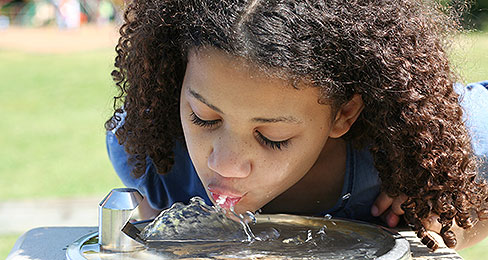
Many kids aren’t, according to a new study published in the American Journal of Public Health.
The study’s lead author, Erica Kenney, a scientist at Harvard’s T.H. Chan School of Public Health, originally planned to look into the amount of sugary drinks kids were consuming in schools. However, during her research she found that many kids were simply not drinking enough water.
Kenney and her team examined data from a group of 4,000 children, ages 6 to19, between the years of 2009 and 2012. The data was taken from the National Health and Nutrition Survey, a study on the health of children in the United States conducted each year by the Center for Disease Control and Prevention.
While looking through the survey results, she noticed that more than half of the kids who participated were dehydrated. Of that group, boys were 76% more likely than girls to not have enough water in their system. Nearly one quarter of the kids in the survey reported drinking no plain water at all.
“These findings are significant because they highlight a potential health issue that has not been given a lot of attention in the past,” Kenney said in a statement. “Even though for most of these kids this is not an immediate, dramatic health threat, this is an issue that could really be reducing quality of life and well-being for many children and youth.”
How much is enough?
The human body is made up of 60% water. It regulates body temperature, delivers oxygen all over the body, assists in digestion, and performs various other tasks that keep our bodies healthy.
Not drinking enough water can lead to health problems such as headaches, irritability, poor physical performance, and even more serious issues. Your body needs more water when you are in hot climates, when you are physically active, and if you have a fever.
The United States National Agriculture Library says on average, kids need between 10 to 14 cups of water every day. This water can come from a mix of drinks and foods that contain high amounts of water, such as celery, melons, or tomatoes. It is also recommended that fluids come from water instead of sugary drinks that are high in calories and can lead to weight problems.
“The good news is that this is a public health problem with a simple solution,” said senior author on the study and professor health sociology at Harvard University, Steven Gortmaker. “If we can focus on helping children drink more water – a low cost, no calorie beverage – we can improve their hydration status, which may allow many children to feel better throughout the day and do better in school.”
Tips for staying hydrated
The United States Center for Disease Control offers the following tips for people to stay hydrated:
– Carry a water bottle for easy access.
– Freeze some freezer-safe water bottles. Take one with you for ice-cold water all day long.
– Choose water instead of sugar-sweetened beverages. This tip can also help with weight management. Substituting water for one 20-ounce sugar-sweetened soda will save you about 240 calories.
– Choose water instead of other beverages when eating out. Generally, you will save money and reduce calories.
– Give your water a little pizzazz by adding a wedge of lime or lemon. This may improve the taste, and you just might drink more water than you usually do.
Source :- Time FOr Kids


Leave a Reply